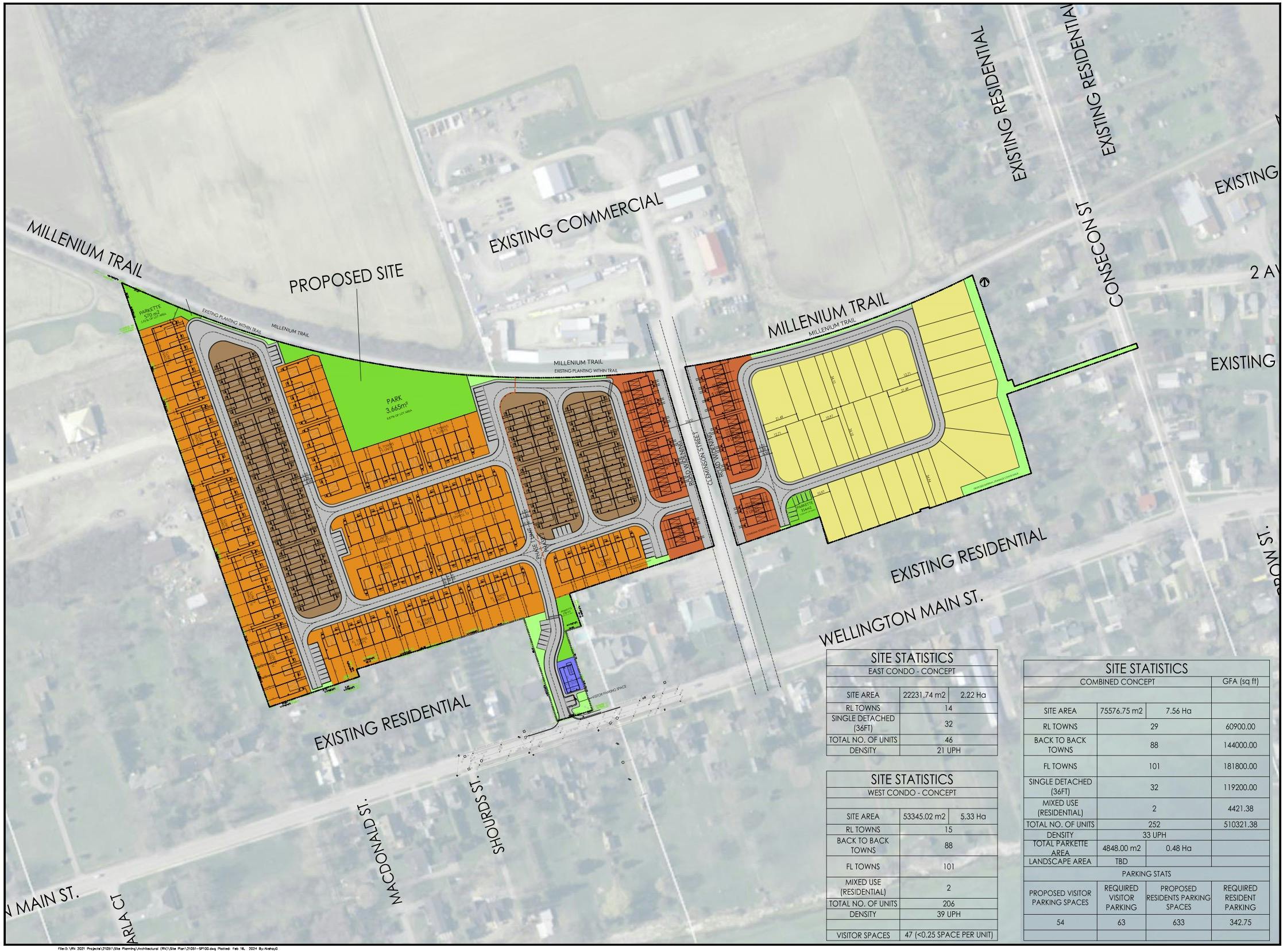 Sterling Homes concept plan (supplied photo)
Sterling Homes concept plan (supplied photo)
Sterling Homes’ re-zoning application was approved last month at Council’s Planning and Development Committee.
The vote came despite strenuous objections from the neighbours who live at Wellington on the Lake.
The project’s main selling point, its promise to offer more affordable varieties of housing with smaller footprints in a mix of styles, was precisely what incensed the neighbours.
Sterling’s density ranges from 14.5 to 39 units per hectare. The majority of the 252-home development features connected townhomes, some on rear lanes, some stacked, some running back-to-back.
There is little room left for greenspace, just over an acre. The one large park borders the Millennium Trail.
“This is all I’m hearing now,” said Sterling’s planner, Jim Levac. “Everywhere I go, density, affordability, those are the keywords.”
Sterling has built similar projects in Niagara-on-the-Lake, Blue Mountain, and Collingwood.
“Those places are facing the same issues as here,” said Mr. Levac. “A growing community needs to offer more services, more restaurants and retail. Those services need workers.”
“Only the workers have nowhere to live.”
“There is a much broader buying demographic here than can now afford to live here. This area is very attractive, for obvious reasons. But affordabilty a real issue,” he continued.
As Sterling’s Paul Mondell noted, “It was made clear to us when we purchased this property that Wellington was looking for a broader range of housing types than are already here.”
“Making units smaller means they are a little more affordable, and more attractive to a younger buyer, younger families trying to get into the housing market. To older buyers retiring and downsizing. Also, second home buyers looking for recreational opportunities.”
Mr. Levac noted that the tremendous escalation in the cost of housing over the past 20 years has advantaged one generation, and priced out another.
Sterling planner Jim Levac
“Prince Edward
County is filled with
$1- and $2-million
dollar homes that many people cannot afford,
certainly the younger demographics, those with young families.”
“My own kids cannot afford to live in the community they grew up in,” he said, echoing the experience of most parents of older kids, whether in Prince Edward County or in the city.
Not in my Front Yard
To residents of WOTL who spoke at the meeting however, planning terms like density, affordability, and “skinny” — an architectural term for 19-ft wide townhouses — have become lightning rods.
Speaker after speaker lamented the “inner-city living conditions” of the proposed development, its laneway housing evocative of “urban back alleys” and “urban crime.”
A key private road at WOTL, Aletha, borders Sterling’s development. Its owner has denied Sterling access to the road. The newcomers had to get creative with the layout of the townhomes that border it, and commit to building another road.
It is proposing a row of townhouses that back onto Aletha, to the fury of the 4 or 6 homeowners whose properties front onto the narrow road they liken to a driveway.
Lara Charlebois noted her property could face 31 two-storey townhouses with small backyards and barbecue patios.
“Who is going to live there? Couples and children? That means potentially 100 people enjoying their barbecues in front of us with no privacy.”
She complained the developers had left “no respectful space nor privacy for those whose curb appeal is going to vanish.”
“They are turning Aletha into a back alley.”
WOTL homeowners want to see more single-family homes like theirs.
“We are not against development, but this is beyond the pale. We want single-family homes, something respectful,” she continued.
As Barry Charlebois added, “This is a complex one would find in a major city, a few feet away from an established retirement community.”
“They want to monetize every morsel of earth they own, I understand, but they don’t have the right to eviscerate the value of our properties.”
Council directed staff to work with the developers to find a solution, from improved landscaping, to fewer townhomes on Aletha.
See it in the newspaper